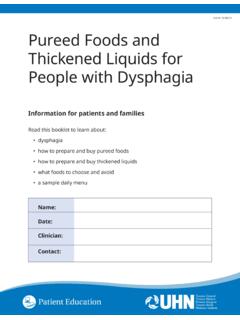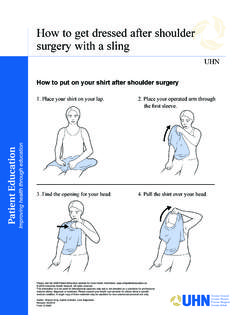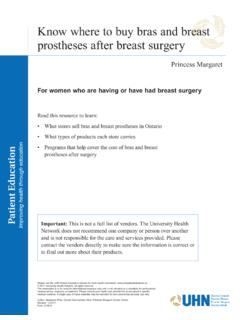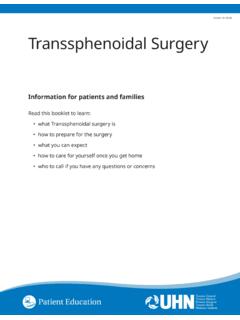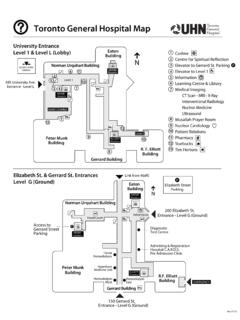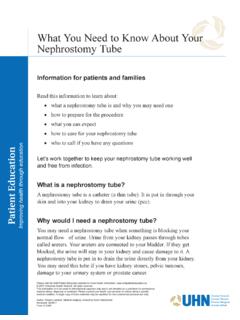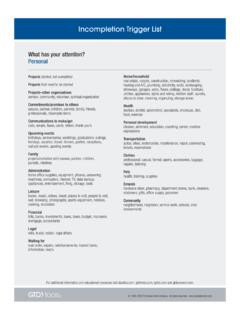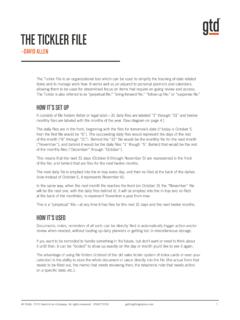Transcription of What to Expect When Getting Port a Cath
1 What to Expect When Getting an Implanted PortInformation for patients and familiesRead this resource to learn: What an implanted port does What to Expect before, during and after you get your implanted port How to care for your implanted port Who to call if you have any questionsForm: D-51412My port will be inserted on: Date: Time: My port will be removed on: Date: Time: Check-in 30 minutes before your appointment at the Medical Imaging reception desk.
2 Your port will be inserted or removed at one of these sites: Toronto General Hospital Peter Munk Building, 1st Floor 585 University Avenue, Toronto General Inquiries: 416 340 3800 Toronto Western Hospital East Wing, 3rd Floor 399 Bathurst Street, Toronto General Inquiries: 416 603 25813 What is an implanted port?An implanted port (also called a port or port-a-cath ) is a type of central venous catheter. It is used to inject liquids directly into your vein as part of your treatment (called intravenous or IV therapy). Why do I need to have a port inserted?Your doctor or nurse may recommend a port for you if: 9you need IV therapy many times over 6 months or longer 9you have small veins and need multiple pokes to get an IV in 9your IV treatment must be given through a port (for example, when Getting chemotherapy multiple days at home) Your nurse can use your port to collect blood samples, and to give: fluids medicines, like chemotherapy and antibiotics a blood transfusion IV nutrient (food) this is called Parenteral NutritionSome implanted ports can also be used for high speed injection during CT scan or MRI test (special kind of x-ray).
3 These ports are called power-injectable ports . Your nurse will let you know if you have a power-injectable port. How long can I have my port? Your port can stay in for the whole time you are on IV treatment, and as long as it is working well and shows no signs of infection. Your doctor will remove your port when you don t need it anymore. 4 What do I need to know about my port?Your implanted port has 2 parts: The port The port is usually placed under your skin about 2 to 3 centimetres below your collar bone. You may feel a round or triangle shaped bump on your skin where the port middle part of the port (called septum or access site ) is made of a self-sealing rubber that holds the port needle safely in place during treatment. Your doctor may order one or two ports depending on your treatment needs.
4 Having two ports means your nurse can inject two different IV treatments at the same time. 5 The catheter Your port is connected to a thin flexible tube called a catheter. The end of the catheter sits in a large blood vessel leading to your heart. When you need IV therapy or blood sample, your nurse will insert a special needle into the port septum. This is called accessing the port . This needle allows fluid or medicine to flow from your port through the catheter and into your bloodstream. The port needle must be covered with a sterile dressing and must be changed every 7 days when in use. Your nurse will remove the port needle when your treatment is should I prepare for Getting a port? Get a blood test done 2 to 3 days before the port is put in, if your doctor asks you to. Tell your doctor if you are taking any blood thinner medicine (such as Aspirin, Tinzaparin, ibuprofen, Advil, Motrin).
5 Do not eat and drink after midnight the night before your procedure. You may have sips of water to take your regular medicine. You may eat a light snack first thing in the morning (no later than 6:00 am) if you have to. A light snack can include one cup of yogurt or one cracker or cookie. Based on the type of blood thinner medicine you take, your doctor may tell you to continue or stop taking the medicine. For example: Type of medicineWhat to doNSAID (for example, ibuprofen, celecoxib, diclofenac, indomethacin)May continue to takeAspirinMay continue to takeAntiplatelet (for example, Plavix, ticagrelor)May continue to takeIf taking Aspirin with NSAID and/or antiplateletStop taking 7 days before procedureCoumadinStop taking 5 days before procedureDabigatran, rivaroxaban, apixabanStop taking 2 days before procedureLow molecular heparin subcutaneous injectionStop taking 1 day before procedure These examples are only recommendations.
6 Make sure to check with your doctor or nurse before stopping your coming to hospital, make sure to: bring your health card (OHIP) carry a list of all medicines you take regularly leave anything of value at home such as jewelry have a family or friend to drive you homeIt is not safe for you to drive home because you will get medicine that will make you drowsy (sleepy).What can I Expect during the procedure?Your port will be inserted in the Interventional Radiology department in Medical Imaging. We will ask you to change into a hospital gown. A medical imaging staff person explains the procedure to you and answers any questions you have. You are asked to sign a consent form before the procedure can start. A needle is inserted into your arm to give you fluid and give you medication to keep you relaxed during the procedure.
7 Let the staff know if you have an allergy to heparin. Heparin is used to prevent blood clots from forming inside your port and catheter. A different type of medicine will be used instead. You lie on a procedure table and stay awake while the port is put in. This usually takes about 30 to 45 minutes. A local anesthetic is injected into your chest area. This numbs the area where the port is inserted. You should only feel a little pain or discomfort during the You are given small amount of a medicine in your IV to help you relax. This medicine can make you drowsy. The doctor will: make 2 small incisions (cuts), one at the base of your neck and another on your chest about 2 to 3 centimetres below your collarbone. insert the port into the opening on your chest. The doctor then tunnels the catheter under your skin toward the cut at the base of your neck and into your vein.
8 Access the port with a port needle to make sure the port is working properly. The needle is left in place if you need IV therapy within 24 to 48 hours. take an x-ray or other type of imaging test to make sure the port and tube are in the right place. A sterile tape or suture is placed over your incisions and covered with a clear dressing. to prevent infection. A gauze may be put underneath the clear dressing if there is bleeding. A nurse will check on you until you are ready to go home. A friend or family member must take you home from hospital. 9 How should I care for my port at home?Day 1 after the procedure: Spend the rest of the day resting at home. You can eat and drink normally. Check your bandage for bleeding. If the exit site bleeds, press firmly on the exit site over the clear bandage with gauze or tissue until the bleeding the bleeding doesn t stop after you press on it for more than 15 minutes, call the emergency contact number (see page 13), or go to the nearest emergency department.
9 You may feel sore and swollen around the area where the port was put in for 1 or 2 days after the procedure. The area may also be bruised, which can take longer to go away. Avoid putting pressure on the incision areas, such as wearing suspenders or a tight bra for the first 1 or 2 days. Avoid lifting anything heavier than kilograms (10 pounds) and doing vigorous exercise for the first week after your port is put in place. Vigorous activities feel challenging and intense, like running, aerobics and heavy yard work. You can return to your normal activities once your incision is healed (usually this takes about 1 week). Day 2 after the procedure: After 2 days, remove the dressing and leave it open to air. If you notice that it is still oozing bloody fluid around the site, cover it with sterile gauze and then tape it.
10 Once the incision site dries, you don t need to cover the area when you shower or when the port is not being used (when there is no needle in your port). Let the water run over the incision but do not scrub it. The stitches on the incision site will dissolve and disappear on their Do not peel the steri-strips (white tape) under the dressing. They will fall off on their own. You can bathe or swim when the incision has completely healed (usually this takes about 14 days). What other things should I know about my port? 9 Your port will stay in place as long as you need it. 9 Your port does not affect CT scans, x-rays or MRI tests. If you need one of these tests, it is safe to have it. 9 Your port must be flushed (cleaned) after each use and once a month when it is not in use. Flushing the port keeps the port clear of blood and medicine.



